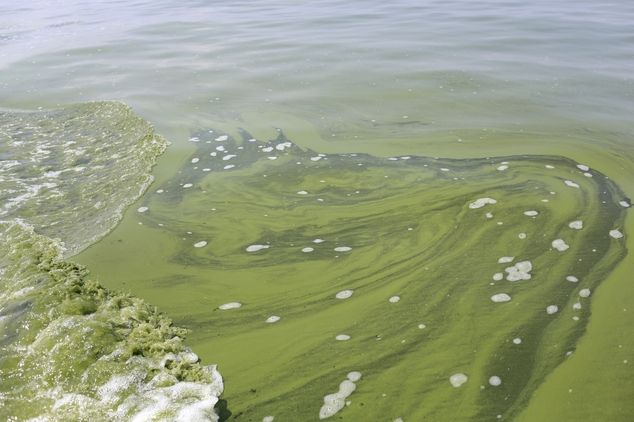 Algae is seen near the City of Toledo water intake crib, Sunday, Aug. 3, 2014, in Lake Erie, about 2.5 miles off the shore of Curtice, Ohio. (AP Photo) Long lines formed at water distribution centers and store shelves were quickly emptied of bottled water after Ohio's fourth-largest city told residents not to drink from its water supply that was fouled by toxins possibly from algae on Lake Erie, azh.kz refers to ap.com.
Algae is seen near the City of Toledo water intake crib, Sunday, Aug. 3, 2014, in Lake Erie, about 2.5 miles off the shore of Curtice, Ohio. (AP Photo) Long lines formed at water distribution centers and store shelves were quickly emptied of bottled water after Ohio's fourth-largest city told residents not to drink from its water supply that was fouled by toxins possibly from algae on Lake Erie, azh.kz refers to ap.com.
The warning effectively cut off the water supply to 400,000 people in Toledo, most of its suburbs and a few areas in southeastern Michigan.
Worried residents told not to drink, brush their teeth or wash dishes with the water emptied store shelves and waited hours for deliveries of bottled water from across Ohio as the governor declared a state of emergency.
Gov. John Kasich pledged that state agencies were working to bring water and other supplies to areas around Toledo while also assisting hospitals and other businesses impacted. The state also was making plans to make more deliveries if the water problem lingered, he said.
"What's more important than water? Water's about life," Kasich said. "We know it's difficult. We know it's frustrating."
The governor said it was too early to say how long the water advisory will last or what caused toxins to spike suddenly in the drinking water.
"We don't really want to speculate on this," Kasich told The Associated Press. "When it comes to this water, we've got be very careful."
Samples of water were flown to the federal and state Environmental Protection Agency offices in Cincinnati and Columbus and a university in Michigan for additional testing, officials said.
Residents waking up to the warning on Saturday morning lined up outside just about any store selling water. Some were mothers concerned about how they would make formula for their infants and other were worried about their elderly parents.
Families toting empty coolers, milk jugs and even cookie jars topped them off with well water funneled out of the back of a pickup truck.
John Myers, a farmer from nearby Swanton, loaded 450 gallons of well water into a container in the back of his pickup truck and gave it out for free in a high school parking lot.
"The more you got, the more we'll fill," he told residents carrying empty containers. "I never thought I'd see the day that I'd be giving water away."
Toledo issued the warning just after midnight Saturday after tests at one treatment plant showed two sample readings for microsystin above the standard for consumption. The city also said not to boil the water because that would only increase the toxin's concentration. The mayor also warned that children should not shower or bathe in the water and that it shouldn't be given to pets.
Algae blooms during the summer have become more frequent and troublesome around the western end of Lake Erie, the shallowest of the five Great Lakes.
The algae growth is fed by phosphorus mainly from farm fertilizer runoff and sewage treatment plants, leaving behind toxins that have contributed to oxygen-deprived dead zones where fish can't survive. The toxins can kill animals and sicken humans.
Most water treatment plants along the western Lake Erie shoreline treat their water to combat the algae. Toledo spent about $4 million last year on chemicals to treat its water and combat the toxins.
 В Атырау -3
В Атырау -3